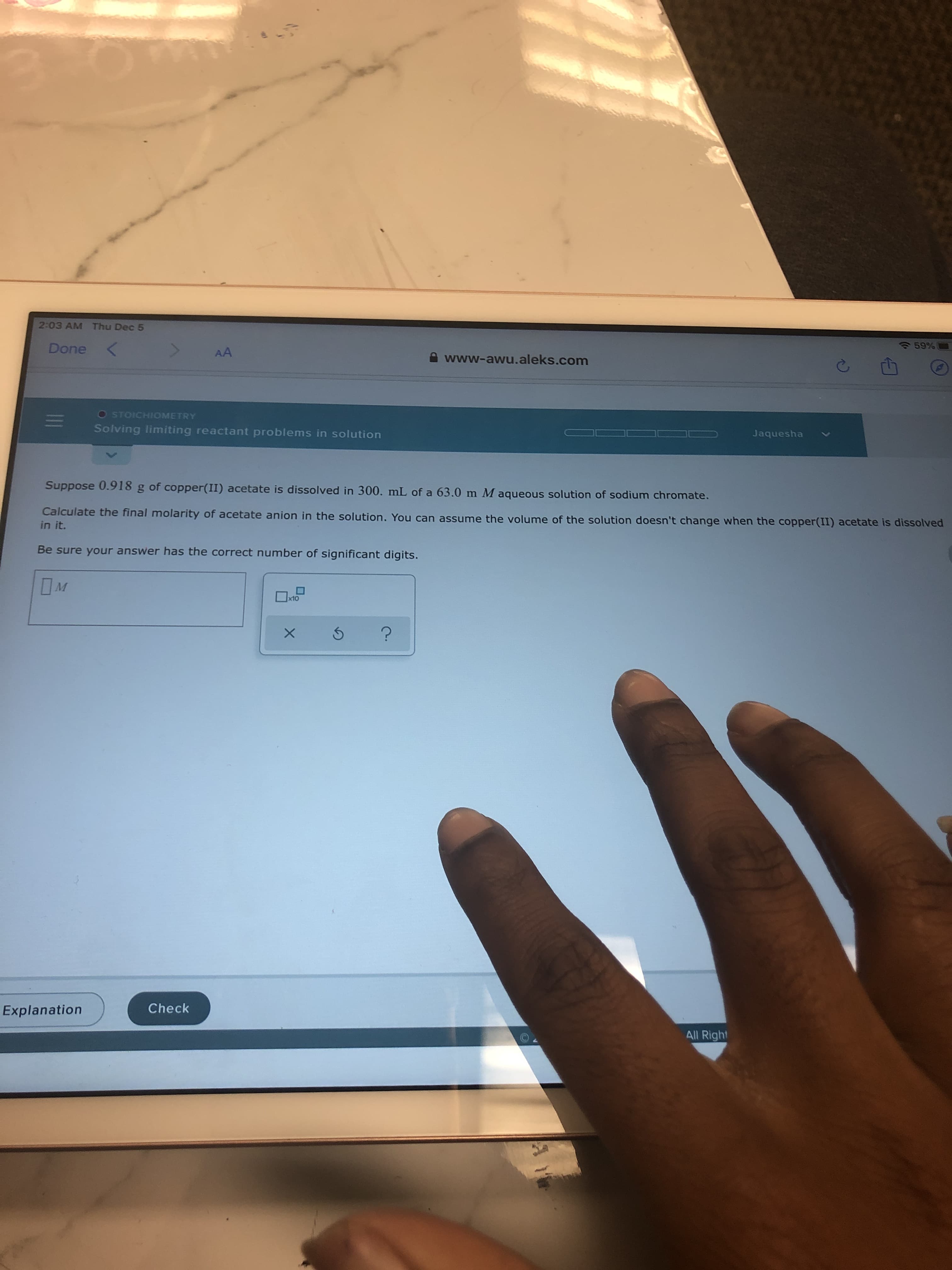2:03 AM Thu Dec 5 Done < AA A www-awu.aleks.com O STOICHIOMETRY Solving limiting reactant problems in solution Jaquesha Suppose 0.918 g of copper(II) acetate is dissolved in 300. mL of a 63.0 m M aqueous solution of sodium chromate. Calculate the final molarity of acetate anion in the solution. You can assume the volume of the solution doesn't change when the copper(II) acetate is dissolved in it. Be sure your answer has the correct number of significant digits. Check Explanation All Right
2:03 AM Thu Dec 5 Done < AA A www-awu.aleks.com O STOICHIOMETRY Solving limiting reactant problems in solution Jaquesha Suppose 0.918 g of copper(II) acetate is dissolved in 300. mL of a 63.0 m M aqueous solution of sodium chromate. Calculate the final molarity of acetate anion in the solution. You can assume the volume of the solution doesn't change when the copper(II) acetate is dissolved in it. Be sure your answer has the correct number of significant digits. Check Explanation All Right
Introduction to General, Organic and Biochemistry
11th Edition
ISBN:9781285869759
Author:Frederick A. Bettelheim, William H. Brown, Mary K. Campbell, Shawn O. Farrell, Omar Torres
Publisher:Frederick A. Bettelheim, William H. Brown, Mary K. Campbell, Shawn O. Farrell, Omar Torres
Chapter2: Atoms
Section: Chapter Questions
Problem 2.32P
Related questions
Question
How do I solve?

Transcribed Image Text:2:03 AM Thu Dec 5
Done <
AA
A www-awu.aleks.com
O STOICHIOMETRY
Solving limiting reactant problems in solution
Jaquesha
Suppose 0.918 g of copper(II) acetate is dissolved in 300. mL of a 63.0 m M aqueous solution of sodium chromate.
Calculate the final molarity of acetate anion in the solution. You can assume the volume of the solution doesn't change when the copper(II) acetate is dissolved
in it.
Be sure your answer has the correct number of significant digits.
Check
Explanation
All Right
Expert Solution
This question has been solved!
Explore an expertly crafted, step-by-step solution for a thorough understanding of key concepts.
This is a popular solution!
Trending now
This is a popular solution!
Step by step
Solved in 5 steps with 4 images

Knowledge Booster
Learn more about
Need a deep-dive on the concept behind this application? Look no further. Learn more about this topic, chemistry and related others by exploring similar questions and additional content below.Recommended textbooks for you

Introduction to General, Organic and Biochemistry
Chemistry
ISBN:
9781285869759
Author:
Frederick A. Bettelheim, William H. Brown, Mary K. Campbell, Shawn O. Farrell, Omar Torres
Publisher:
Cengage Learning

Introductory Chemistry: A Foundation
Chemistry
ISBN:
9781337399425
Author:
Steven S. Zumdahl, Donald J. DeCoste
Publisher:
Cengage Learning

Chemistry: Principles and Reactions
Chemistry
ISBN:
9781305079373
Author:
William L. Masterton, Cecile N. Hurley
Publisher:
Cengage Learning

Introduction to General, Organic and Biochemistry
Chemistry
ISBN:
9781285869759
Author:
Frederick A. Bettelheim, William H. Brown, Mary K. Campbell, Shawn O. Farrell, Omar Torres
Publisher:
Cengage Learning

Introductory Chemistry: A Foundation
Chemistry
ISBN:
9781337399425
Author:
Steven S. Zumdahl, Donald J. DeCoste
Publisher:
Cengage Learning

Chemistry: Principles and Reactions
Chemistry
ISBN:
9781305079373
Author:
William L. Masterton, Cecile N. Hurley
Publisher:
Cengage Learning
